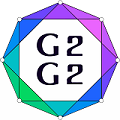Minicourse 1 (MC1)
Title: Using the GAP system and its packages for research in graph theory, design theory, and finite geometry (10 hours)
Lecturer: Leonard Soicher, Queen Mary University of London, UK
Description: GAP is an internationally developed, open-source, freely available system for computational discrete algebra, with a particular emphasis on computational group theory. GAP and its packages are used worldwide for research in groups and representation theory, ring theory, algebras, combinatorics, number theory, algebraic topology, geometry, and more. A bibliography at https://www.gap-system.org/Doc/Bib/bib.html lists almost 3000 publications citing GAP. In 2008, GAP was awarded the ACM/SIGSAM Richard Dimick Jenks Memorial Prize for Excellence in Software Engineering applied to Computer Algebra. GAP packages (included with GAP) provide additional specialist functionality to the main GAP system. See the GAP website https://www.gap-system.org for much more information and to download the latest version of GAP.
In this course, I will give advanced mathematics students an introduction to GAP and its packages GRAPE (for computing with graphs together with groups acting on them), Digraphs (for computing with directed graphs), DESIGN (for constructing, classifying, partitioning, and studying block designs), and FinInG (for computation with finite incidence geometries). The emphasis will be on enabling the students to do computations relevant to their research interests in the areas of graphs and groups, designs, and finite geometries. The students are expected to have a background in basic graph theory and group theory, including permutation groups. Experience in computer programming is helpful, but not necessary.
Proposed outline of the course:
Lectures 1 and 2. Introduction to the GAP system. Topics to include: GAP statements, functions, and data structures, simple programming in GAP, and permutation groups in GAP.
Lectures 3 and 4. The GRAPE package. Topics to include: the structure of a graph in GRAPE, constructing and analysing graphs and subgraphs in GRAPE, determining regularity properties of graphs, automorphism groups and isomorphism testing for graphs, clique classification, and proper vertex colouring.
Lecture 5. An overview of the Digraphs package for computing with directed graphs.
Lectures 6 and 7. Overviews of the DESIGN package for the construction and analysis of block designs and the FinInG package for finite incidence geometry.
Lecture 8-10. Some research applications of GAP and the packages studied.
Software:
Ideally, participants should have access to a computer running Linux (or some version of Unix), on which the most recent distribution of GAP is installed (version 4.11.1), together with fully installed versions of this distribution's included packages GRAPE, DESIGN, Digraphs and FinInG. If this is not fully possible, then the following are essential.
For the first exercise session, a participant needs to have access to a computer with a recent version of GAP (at least version 4.11.0).
For the second exercise session, they must have in addition the included packages GRAPE 4.8.3 and DESIGN 1.7 fully installed. Again, it is best to be running a version of Unix on their computer.
Although I am not assuming any previous experience with GAP, if a participant has little or no experience of using GAP, then I recommend that they look through the tutorial https://www.gap-system.org/Manuals/doc/tut/chap0.html before the minicourse.
Exercises and lecture notes:
I have put my minicourse exercises and lecture notes for first two lectures of
this minicourse at:
http://www.maths.qmul.ac.uk/~lsoicher/g2g2/
Q&A:
- How difficult is to add new GAP packages if I'm using Gap.app?
- The Gap.app 0.61 release includes GAP 4.11.0, GRAPE 4.8.3, and DESIGN 1.7.
You need to load the packages into the workspace, which you can do with the command
gap > LoadPackage("design");
(which will load both of them, since GRAPE is a prereq for DESIGN).
- The Gap.app 0.61 release includes GAP 4.11.0, GRAPE 4.8.3, and DESIGN 1.7.
Minicourse 2 (MC2)
Title: Introduction to vertex algebras and vertex operator algebras (10 hours)
Lecturer: Atsushi Matsuo, The University of Tokyo, Japan
Description: The development of vertex operator algebras was motivated by the Monster group and played a major role in the proof of Monstrous moonshine by Borcherds in 1992. Borcherds was later awarded a Fields medal, in part for his work on moonshine and vertex operator algebras. These algebras were the motivation for the introduction of Majorana algebras, and the closely related axial algebras, that are of growing significance in the study of finite groups.
In this course, we will give an overview of basics of vertex algebras (VA) and vertex operator algebras (VOA) so that the students will be able to understand advanced topics related to group theory and combinatorics. We will start with affine Lie algebras and Virasoro algebras, which give rise to important classes of VAs, and proceed to the definitions of VAs and VOAs and their basic properties. Among various examples, the lattice VAs and their modules will be treated in some detail. Some of more advanced topics on representation theory of VOAs will also be covered.
Proposed outline of the course:
Lecture 1. Affine Lie algebras and Virasoro algebra.
Lecture 2. Basics on vertex algebras.
Lecture 3. Vertex operator algebras.
Lecture 4. Lattice vertex algebras.
Lecture 5. Classification of simple modules.
Lecture 6. Determination of fusion rules.
Lecture 7. Twised modules and their applications.
Lecture 8. Modular invariance of characters.
Lectures 9 and 10. Applications of VAs and VOAs.

